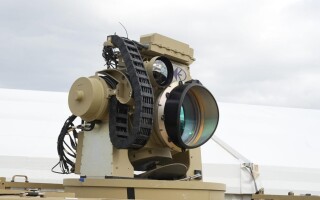Sensor Open Systems Architecture (SOSA), an overview
StoryMarch 17, 2017

Budget cuts and sequestration, while handcuffing the defense industry and the warfighter, have also forced the government to embrace a movement toward more commonality across multiple platforms through open standards and establishing a culture of re-use. One such initiative, the Sensor Open Systems Architecture (SOSA), creates modular open systems architecture specifications to enable re-use of key sensor components across multiple platforms and services. In this Q&A with Dr. Ilya Lipkin, Lead Manager for SOSA at the U.S. Air Force Life Cycle Management Center, explains SOSA, its similarities to other initiatives like the Future Airborne Capability Environment (FACE), how standards organizations like VITA are involved, and why today?s procurement environment is so open to initiatives such as SOSA.
MCHALE REPORT: Please provide a brief description of your responsibility within the Air Force Life Cycle Management Center (AFLCMC) and its overall role within the Air Force?
LIPKIN: My responsibilities within the Air Force are to support existing programs and our acquisition activities at AFLCMC for Intelligence, Surveillance, Reconnaissance, & Special Operations Forces Directorate. Within the Air Force AFLCMC is one of six centers under Air Force Materiel Command; the Air Force Life Cycle Management Center is the single center responsible for total life cycle management of Air Force weapon systems. The AFLCMC Mission: “Acquire and Support War-Winning Capabilities” Our Motto: “AFLCMC... Providing the Warfighter’s Edge” (source http://www.wpafb.af.mil/aflcmc).
MCHALE REPORT: What is the Sensor Open Systems Architecture (SOSA) and why was it created?
LIPKIN: The Sensor Open System Architecture (SOSA) effort was created to develop a series of modular open systems architecture specifications for a variety of Multi-INT C4ISR platforms that crosses services and platform environment. Specifically, SOSA is business/acquisition practices and a technical environment for sensors and C4ISR payloads that foster innovation, industry engagement, competition, and allow for rapid fielding of cost-effective capabilities and platform mission reconfiguration while minimizing logistical requirements for the following set of initial modalities: radar/synthetic aperture radar (SAR), SIGINT [signals intelligence], electronic warfare (EW), communications, and electro-optics/infrared (EO/IR). The SOSA initiative is being incubated as part of the FACE consortium of The Open Group, and is going through activities to create attractive business and technical draft snapshot products to stand up as part of an ecosystem of related and relevant standards that work together.
MCHALE REPORT: How is SOSA similar to the Navy’s FACE effort and the Army’s Open Mission Systems (OMS)?
LIPKIN: SOSA is complimentary effort that functions seamlessly with FACE and OMS. SOSA is inherently agnostic to FACE and OMS. The SOSA Software WG is developing an architecture that could, quite possibly, heavily leverage both FACE and OMS. Furthermore, there are other open architecture initiatives that are being considered for SOSA to leverage e.g.: REDHAWK, MBE-RF, SAE SPIE, VITA, and many other initiatives across software, hardware, and electrical interfaces.
MCHALE REPORT: What is the timetable for seeing SOSA compliant architectures/interfaces in deployed systems? Are there any programs already adopting SOSA?
LIPKIN: Currently SOSA is about one year old, and it will take some time to develop relevant standards. However the snapshot of several SOSA compliant architectures/interfaces should be released over the next couple of month for areas that we feel are mature to be inserted for consideration into existing programs of record as either part of the upgrade, or new starts, with incremental development strategy. Hence, a lot of SOSA activities are based on existing industry supported standards. I am confident that we can release SOSA specifications as soon as consensus is reached on the right technologies to push forward.
The challenge is that there are many open architectures and choosing the right one is the key for a 30 - 40 year lifecycle implementation into our systems. Currently there is one program that has adopted SOSA, AFRL’s AgilePod T Program – a proof of concept Multi-Int ISR, reconfigurable, open architecture developmental platform. We are using AgilePod to help validate certain elements of the SOSA architecture and standards for eventual integration into operationally fielded platforms. Furthermore, there are small business innovation research opportunities for SOSA development through AFRL portal, and more is being planned for the future.
MCHALE REPORT: How does SOSA leverage the work being done with the Navy’s Hardware Open Systems Technology (HOST)?
LIPKIN: The SOSA Hardware WG is leveraging NAVAIR’s HOST effort via adoption of HOST’s existing module, backplane, and slot profiles. This also leverages an ongoing hardware convergence effort between the Air Force, Army, and Navy. Each slot profile and module profile will get used in the SOSA architecture.
MCHALE REPORT: Which current and in-development VITA standards will be leveraged within SOSA?
LIPKIN: These existing standards are leveraged: VITA 65, VITA 46, VITA 48, VITA 48.2, VITA 62, VITA 49, and VITA 49.2.
MCHALE REPORT: Are there other standards bodies aside from VITA you are working with on SOSA?
LIPKIN: I believe there is a relationship between The Open Group and SAE, as well hence some of the standards chosen to move forward are part of SAE.
MCHALE REPORT: Why is the climate within the Department of Defense (DoD) community today more conducive to efforts such as SOSA and FACE than in the past? More collaboration? Or is it a result of budgetary pressures forcing more commonality?
LIPKIN: The DoD and Government community realizes that current and future systems are growing in complexity. Disparate groups and entities have seen, independently, the benefit of moving to a modular open architecture environment for a wide variety of applications. There is a convergence of applications that are data and information driven. This, in turn, drives commonality across hardware and software modules.
MCHALE REPORT: Where online can readers learn more about SOSA?
LIPKIN: Currently to gain detailed information on SOSA requires membership in FACE Consortium, however after incubation activities are completed the snapshots, and technical standard will be available from The Open Group in the exact same way as FACE: https://www.opengroup.us/sosa.
Dr. Ilya Lipkin is a project software engineer for the U.S. Air Force Life Cycle Management Center (AFLCMC). Previously he was assigned to Hill Air Force Base 309th SMXG where he developed embedded Drive by Wire software systems for Expeditionary Fighting Vehicle (EFV), His next assignment was at AFLCMC Wright Patterson AFB where he lead MQ-1/MQ-9 and Global Hawk Training Systems. He is a member of the AFLCMC software working group AFSIP, Future Airborne Capability Environment (FACE), and Sensor Open Systems Architecture (SOSA) working groups. His current research interests are in automated machine learning and pattern recognition algorithms, software architecture, and multi-INT sensor decomposition. Ilya has numerous publications in Journal of Defense Software Engineering Crosstalk, IITSEC, and Decision Sciences Journal as well as numerous conferences. He has MSE computer engineering from University of Michigan, an MBA in Operations Management, and a PhD in Software Project Productivity from University of Toledo. Ilya is currently assigned to AFLCMC/WING to RDUCE, and SOSA where he leads development efforts in partnership with AFRL for SAR, and HSI compression, as well as SOSA Consortia for the U.S. Air Force.





